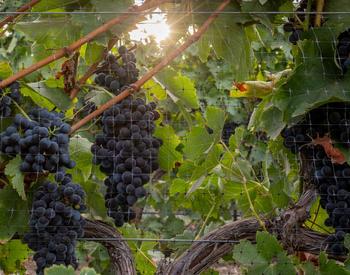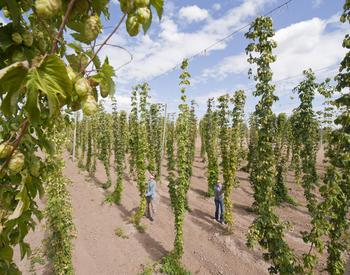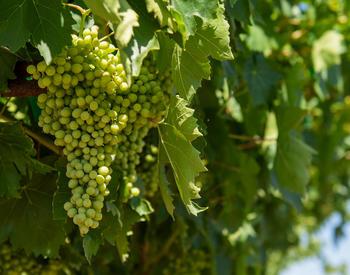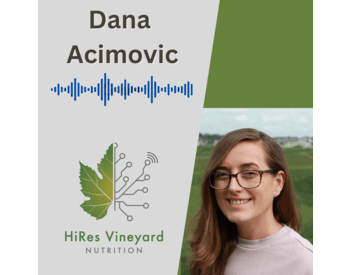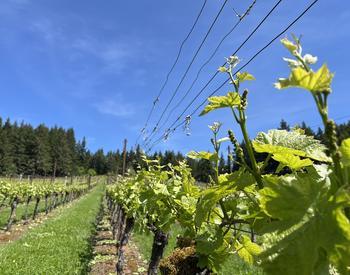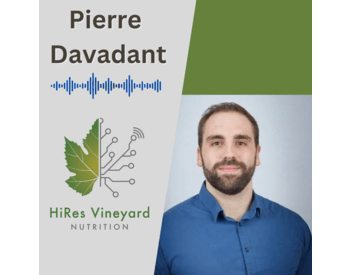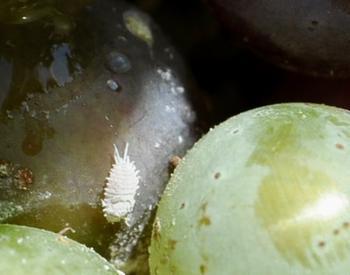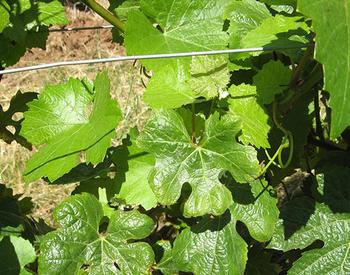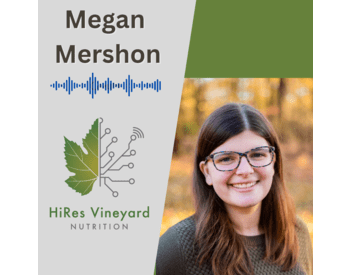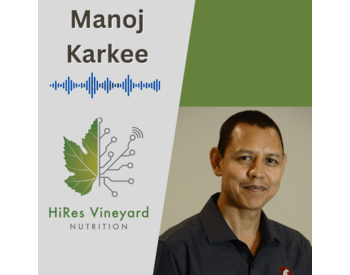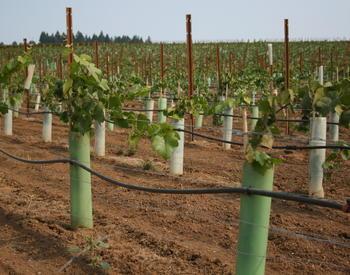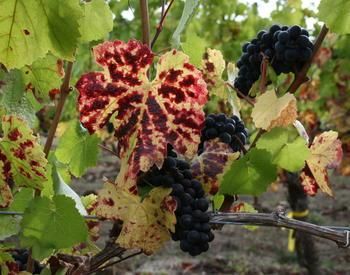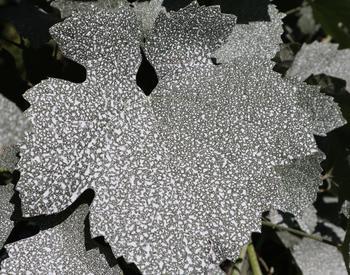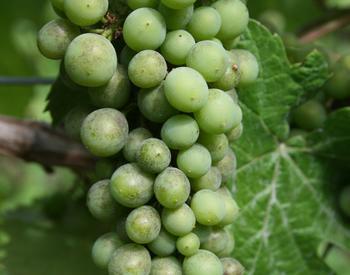Transcript
(00:00:00) Patty Skinkis
This is the High-Res Vineyard Nutrition Podcast, devoted to helping the grape and wine industry understand more about how to monitor and manage vineyard health through grapevine nutrition research. I am your host, Dr. Patty Skinkis, Professor and Viticulture Extension Specialist at Oregon State University.
(00:22) Patty Skinkis
Vineyard nutrition is impacted by many factors, including soil type, characteristics, weather conditions, climate, the cultivar you're growing, your rootstock, and many other factors. Often viticulture practices across the US vary due to these conditions. Yet many viticulturists across the US use the same vineyard nutrient management sampling methods and tissue interpretations. A key objective of the High-Resolution Vineyard Nutrition Project is to determine how to manage vineyard nutrition across regions and cultivars. To learn more about how the eastern US manages find nutrition, we have Dr. Justine Vanden Heuvel with us today.
Dr. Justine Vanden Heuvel is one of 14 scientists working as co-principal investigators (co-PIs) in the HiRes Vineyard Nutrition Project. She is working with two different teams, including the plant nutrition and product quality team and the precision viticulture team. This research project extends her prior research in developing sustainable grape production methods focused on eastern US wine grape production.
Justine has conducted a wide array of viticulture research from canopy management studies to projects on vineyard floor management, cover crops, and soil health. Her link to this project was based on her recent work on vine nutrition and precision agriculture. Justine is a professor of viticulture at Cornell University where she is involved in research and teaching. She is also chair of the Horticulture Section of the School of Integrated Plant Sciences. Justine is going to share some of her information about vineyard nutrition in the eastern US and her research that's being done to advance sustainable nutrient management.
Welcome Justine.
(00:02:00) Dr. Justine Vanden Heuvel
Hello Patty thanks for having me.
(00:02:02) Dr. Patty Skinkis
So, the beginning part of our research project with HiRes Vineyard Nutrition included information about what growers do across the US, and we had a survey. I know you were part of this survey to determine how growers, whether they're wine grape growers, juice grape growers, table grape growers, how they look at nutrient management; and for the most part, many were doing the same practices. Such as using bloom time petioles to determine their vine nutrient status, yet we know there's a lot of differences in how nutrient management occurs because we have different climates. So, in New York state along with Pennsylvania, Michigan, and Washington, there's both wine grape and juice grapes being produced and we know their goals differ. But do vineyards in your region or New York, in particular, have different inputs between the two production systems?
(00:02:56) Justine Vanden Heuvel
They sure do, because the goals, as you mentioned, are so different in juice grape production compared to wine grape production. So, most of our juice grapes here in New York are produced in western New York, sort of along the south shore of Lake Erie. And so, there's a couple of things that really make that region different than where I'm located in upstate New York in the Finger Lakes region. They are on a much sandier soil than we are, and so they're trying to produce large Concord or Niagara vines with huge crops because it's so difficult to be economically sustainable when we're looking at juice grape production. And they also have to be very cautious with their nutrient additions because they are located along the Great Lakes. And so, their approach tends to be pretty different in terms of what nutrients they'll put on, how much, and when, compared to wine grapes. Here in the Finger Lakes where I am, we have really high organic matter soils. A lot of our soils are 3.5% to 4%, so lots of nutrients, really good water holding capacity, and so we tend to have a bit more of a buffering capacity for that. Particularly because we're producing smaller crops and so the crop isn't pulling as much on the vine for nutrients as it is in juice grape production.
(00::0428) Patty Skinkis:
So, the nutritional needs are different mainly because of those characteristics of the growing areas. Do you find that growers between those two locations look at their tissues? Do they look at tissues or soil more often?
(00:4:42) Justine Vanden Heuvel
Yeah, so in my experience, the juice grape producers will look at tissue sampling more often than the wine grape producers will. Again, it's because they're carrying a bigger crop load and they really need those vines to produce. So, I think they will more frequently sample every year, usually bloom time petioles. Whereas the wine grape growers, well, they're not quite as consistent with sampling every year. They might sample every other year or sometimes even every third year until they see a problem. And mostly in terms of soil sampling really, it's only if growers think that there's a problem that they'll usually run a nutrient analysis on the soil.
(00:05:26) Patty Skinkis:
So, it probably is also related to how many inputs that they put in between the juice and the wine grapes. So, if they're doing three more inputs they're testing more to kind of guide those decisions.
(00:05:37) Justine Vanden Heuvel:
Well, I don't know if I would say it's more inputs but it's more valuable inputs to them because for juice grapes the price is so low and the production costs are reasonably high and so it's difficult to make money. So, making a decision about whether to add one more input, is really key right? And it might be the difference between being in the black and being in the red economically for the season. Whereas in wine grapes, some people are making money, some people are not, but there's a lot more room to play there in terms of deciding on those inputs because the price of the grapes is significantly higher.
(00:06:19) Patty Skinkis
I like that viewpoint, a lot of times we think if you have more of a vineyard budget, you can spend more money on testing at least that's what we hear from a lot of growers here in Oregon, but I like that idea of, if you need to save more money testing can save a lot of money versus having those additional inputs so that's a good thing for everyone to keep in mind.
(00:06:42) Justine Vanden Heuvel
Right? Yeah, there's the economic sustainability there and there's the environmental sustainability is we don't want people putting on for example, nitrogen, that can leach through the soil and into nearby waterways if they don't need to be.
(00:06:57) Patty Skinkis
Do you have any sustainability groups or certifications in New York that are possibly driving use of more sampling? We have that situation where a lot of the certification bodies, the farming certification bodies, are requiring that tissue sampling is done before any inputs are in place. Do you find that to be true in New York?
(00:07:18) Justine Vanden Heuvel
Yeah, that's a really good question. So, there's two major sustainability programs. There's the Long Island Sustainable Wine Growing, and I'm not sure whether sampling is a part of their program, but I would suspect that it is. I would be surprised if it wasn't. Then, there's a program just starting here in the Finger Lakes region and sampling is an important part of that as well.
(00:07:45) Patty Skinkis
That's always great to hear that there's some data behind those inputs and I think that's kind of the first start we're seeing more people doing this because of those certifications. Earlier I asked you about the inputs between juice grapes and wine grapes. Do you see a lot of inputs in the wine grape sector, even though there's not a lot of need perhaps for some of the macronutrients? Do you find that there's other, perhaps more foliar, or lower analysis, so lower concentration of nutrient products being added?
(00:08:21) Justine Vanden Heuvel
So, I think particularly when it comes to micronutrients the answer would be yes is that we see those going on in foliar sprays. Sometimes without any data to justify their addition. We don't see a lot of ground applied macronutrients going on unless growers think it's really necessary.
(00:08:40) Patty Skinkis
We see the same thing within wine grapes. There's a lot of foliar sprays and oftentimes growers are saying, well, that's just cheap insurance. It's not really hot in terms of its concentration of nutrients but it just helps increase the sweet. I know this is always challenging to test in a trial like the HiRes Vineyard Nutrition Project and we threw around the idea of looking at other micronutrients. Do you think there is or know of any research that's being done on some of these foliar micronutrient sprays? Or even some of these other products that people are spraying that might be organic that are foliar applications?
(00:09:21) Justine Vanden Heuvel
You know that's a really good question and I don't know of anything off the top of my head. It seems like, I think because they're often put out in the marketplace by smaller companies that are less likely to sponsor research, they don't tend to hit the radar of many researchers. So, I think there's probably a pretty strong need there considering that I think growers are often spending money on these products without really understanding whether they work. I don't think there's much data to back that up at this point.
(00:09:54) Patty Skinkis
Yeah, yeah, I agree there's a lot of interest and a lot of uses but not much to go behind it. So, I'm going to take us down a different direction. I know you've done a lot of work on vineyard floor management and cover crop trials in New York and with also some collaborators in the east. How much does vineyard floor management play into the entire vineyard nutrient management plan?
(00:10:18) Justine Vanden Heuvel
So that's a good question and it really depends on the region. So, we have four major grape growing regions here in New York and then some minor ones. As I mentioned, western New York, they have very sandy soil. So, much lower in most nutrients than we have here in the in the Finger Lakes region. So, part of it is just the soil you're on, the climate you're on, the amount of precipitation, and how that plays into it. Another one of our regions is Long Island, and Alice Wise, who works for Cornell Cooperative Extension out there, has done a lot of work on undervine cover crops as well. So here in the east we normally maintain a permanent cover crop between the rows, and then we're talking about adding a cover crop directly under the vine so that we don't have bare soil in the vineyard. And the idea is that we don't really need bear soil in the vineyard because most of the time, and there are some exceptions certainly, but most of the time our vines are too big. Right? So, we have to hedge multiple times in the growing season. We have to go through and do a couple of different leaf removal trips through. And then we're herbiciding under the vines to get rid of the competition so we get more vegetative growth and it really doesn't make a lot of sense. So, on Long Island where they've had pretty sandy soils, and a number of growers have adopted this practice. They have had to adjust their nutrient additions because their vines were, in many cases, notably low on nitrogen when they were using an undervine cover crop and it depended what the undervine cover crop was. Here in the Finger Lakes we haven't seen as much of an impact because, again we've got these really high organic matter soils. It's been a little bit hard to predict because what the most popular choice is what we call natural vegetation which is basically, let the weeds grow and then mow them before they get up in the fruiting zone. And so, it's hard to predict site by site what is going to come up in that stand and how competitive is it going to be. But, that's one of the reasons we'd like to see growers here in the Finger Lakes sample for leaf blade nutrients more often, at least every year on a block by block basis. So that they can make adjustments based on the water and nutrients that that undervine cover crop is competing for with the vine.
(00:12:40) Patty Skinkis
You mentioned leaf blade, is that leaf blade rather than petiole? And which time point do you recommend?
(00:12:48) Justine Vanden Heuvel
Yeah, so I'm pushing hard for leaf blade because… well I was going to say petioles don't photosynthesize I actually don't know that to be true, but they don't photosynthesize in any significant manner. And so, when we think about it, it makes more sense for us to be looking at the nutrients in leaf blades because that's our photosynthetic unit. I've heard a story, and I do not know if this is true, but that Pete Christiansen, who developed a lot of the protocols for petiole sampling out of University of California, made a comment that petioles fit into bags in this truck better than leaf blades do. So, don't know if that's true, but it might drive why we do some of this petiole sampling. We have some data sets for Riesling and Cabernet franc over multiple years that really shows a very poor correlation for most macro- and micronutrients between what's in the petiole and what's in the leaf blade, and it's very dependent on whether we've sampled at bloom or veraison, that relationship between petiole and leaf blade. For that reason, we've been trying to get growers to sample leaf blades because we think it just gives us a more accurate and realistic picture of what's going on nutritionally with the vine.
(00:14:07) Patty Skinkis
So, are you recommending at both of those time points, bloom and veraison, or you do recommend just 1?
(00:14:13) Justine Vanden Heuvel
So, I think bloom is optimal because it gives growers enough time to make adjustments before there's this really significant nutritional pull on the vine in terms of fruit ripening. But I think if they can't get it done at bloom, then veraison makes sense as well. But I think the goal in terms of using our resources wisely should be a single bloom sampling, and then making adjustments early in the season so that the vine has time to respond.
(00:14:47) Patty Skinkis
So which nutrients do you typically see, or is there a nutrient that growers typically see being a problem say in the Finger Lakes or in the long Island area? Is there a uniform or generality that you see or is it kind of all over the board?
(00:15:04) Justine Vanden Heuvel
Yeah, mostly all over the board. I work primarily in the Finger Lakes but long island it looks to me like nitrogen and magnesium tend to be more of an issue. Western New York where we're growing juice grapes, I think potassium tends to be the big one. Here in the Finger Lakes it's more often potassium that we see but sometimes we get surprised on things like magnesium or even boron.
(00:15:32) Patty Skinkis
It's interesting that a lot of our higher vineyard areas that are similar to your region in the Finger Lakes we typically see boron, magnesium, rarely potassium, however, for us here in western Oregon so it just kind of exemplifies the differences that can exist within each region.
(00:15:53) Justine Vanden Heuvel:
Right. We also have a split in soil. So, the Finger Lakes are a series of lakes that run north to south, and about halfway up the lake we go from having low pH, low phosphorous soil, to having much higher pH, higher phosphorous soil. And it's just how those lakes were formed by the glaciers, but you know a vineyard, you can have a vineyard ten miles up the road that will have a very different nutritional profile than the one to the south of it. It adds a certain complication to trying to make recommendations around here.
(00:16:32) Patty Skinkis
So, can you tell us a little bit about the research you are conducting within the HiRes Vineyard Nutrition Project? For example, what are the main objectives and outcomes that you see coming in the near future?
(00:16:43) Justine Vanden Heuvel
Yeah, so we have a few different things we are working on for the project. One is that we're collaborating with the team at the Rochester Institute of Technology, that's Jan van Aardt and Rob Chancia, and they are doing hyperspectral imaging on vineyards, to try to determine what the spectral signature is for nitrogen and potassium deficiencies. The idea is that we wouldn't have to sample leaf blades. Eventually there'll be a satellite that will give free hyperspectral images that growers could potentially use to identify nutrient deficiencies. So, we collaborate with them on that but primarily my group has been working on how to best sample vineyards more accurately but more efficiently so that growers will want to take the sample. So, one thing that's challenging that we say to growers. Okay, every year at bloom take a large random sample of the block. So, first of all, no one wants to really take a large random sample because that takes a lot of time. Drive up and down every other row in each of your blocks. Second of all most people don't end up taking a large random sample. They kind of sample from the corners or and then once from the middle. We often don't know how accurate those samples really are in terms of representing what's the variability in nutrients that is within that block. If you think about why we take a large random sample, it's because we don't understand the variability, and we want to make sure we encompass that variability. Rally, we know what the variability is and we can get that from a number of different data streams that we use in viticulture so we are using free, readily available satellite images that come from Sentinel 1 and Sentinel 2 from the European Space Agency. We use SAR, which is Synthetic Aperture Radar, which is basically a proxy for different soil conditions, specifically soil moisture. And then we use NDVI from Sentinel 2, which is the Normalized Difference Vegetation Index, which is sort of a rough proxy for our canopy size. We put those together and used a clustering method, and then we have an algorithm that chooses places in the vineyard sample that cover the variability of the whole vineyard without going to the whole vineyard. So, you know if you go to this spot in the vineyard, you now cover these certain number of pixels. And for us, it's anywhere between 3 and 9 pixels and from the single location then you will have encompassed all of the variability that's there, but you only really had to drive to one spot, and you only really had to take a smaller sample. Our goal is just to make it easier and cheaper for growers to get those leaf blade samples that we're trying to encourage them to get.
(00:19:53) Patty Skinkis
I think that's very interesting because it speaks to that challenge of doing the work. We can always have the best procedure down but ultimately grape growers are busy doing other things and it's not always easy to do it perfectly like we would as scientists. So, it's very interesting work to hear that sampling, all the things we take for granted some of that work being done so that's excellent. So, I know you're collaborating with engineers. Are there other individuals within the eastern section of the United States that you're working with on the viticulture trials to test some of the nutrient guideline type work?
(00:20:36) Justine Vanden Heuvel
We're also collaborating with Terry Bates who's also with Cornell, down in in Western New York. And we're working on this sort of leaf blade versus petiole question for some of our vineyard blocks, and I should mention Markus Keller's group at Washington State has been helping us out with vineyard sampling for some of their blocks too. So really, we've been trying to take advantage of blocks that are already being sampled, and then we just send our request along and say okay sample here, here, and here. So, that fits from our algorithm so that we can test that out.
(00:21:18) Patty Skinkis
Excellent. So, it's hopefully soon we'll see how well they do in these research plots that are much more controlled, shall we say, than in a typical setting.
(00:21:28) Justine Vanden Heuvel:
We've been sampling grower blocks and research blocks and so our comparison is… some of our blocks we sample at a very high spatial resolution. So, if a Sentinel, which is the satellite pixel, is ten meters by ten meters, we sample every pixel in the vineyard to make sure that that we can really look at how accurate our sampling is compared to a random sample, and so far, so good. I think last year, if we look at our average errors, we mostly end up with an average error of less than percent for macro and micronutrients. Our algorithmic sampling based on satellites, we end up with an error that runs anywhere from about 1 to 5 percent. We are giving up, potentially, some precision there but you know we haven't quantified the time, but I would say it probably takes about one-tenth of the time to sample a block using our method compared to collecting a random sample like we ask growers to do.
(00:22:40) Patty Skinkis
That's a big time difference. So that's interesting to hear.
(00:22:43) Justine Vanden Heuvel
Right, and it's still hard for growers to find labor right now as well, right? So even if they want to get these samples, having the labor available to go get them is tricky as well.
(00:22:52) Patty Skinkis
Yeah, we used to have growers say, well we'll just get an intern to do it all, and I think it's a challenge. It's a challenge to find interns.
(00:23:00) Justine Vanden Heuvel
Right. Well, here at Cornell, for our undergraduate program, we probably got 10 to 15 internships sent to us for every student that we have. Unfortunately, most vineyards didn't get an intern when they wanted one.
(00:23:12)) Patty Skinkis
Yeah, similar situation here at Oregon State University as well. Lots of opportunity for students out there who are listening and wanting to get into the wine and grape industry.
What do you think will be the most important and or long-term outcome of this research for growers in your state or region?
(00:23:32) Justine Vanden Heuvel
I've talked about how we're working on these sampling plans, and the idea is that we'll build an API or a plugin for the My Efficient Vineyard platform, so that growers will just go onto a map, outline their block, the program will go, and get this free readily available satellite data, and on its own run the algorithm and tell growers where to sample. But I think the long-term goal needs to be that growers don't sample. It's great to have footsteps out in the vineyard, but when that costs money and time then it's sort of more difficult to justify and I think the RIT team, and I know there's a team at Washington State and UC Davis as well who are in the engineering group and working on this idea that we can use hyperspectral sensing to detect these nutrient deficiencies. I think that is going to be the big exciting result of this project, is that you know, hopefully five to ten years from now, unless there's something weird going on in a block or it's a very small block or there's some variability, then hopefully this data just comes to growers automatically and we are able to detect these nutrient deficiencies and then have them address it in good time.
(00:24:55) Patty Skinkis
I think that's gets at the core of why we even got started on this project, specifically that request, can we start to get a tool or a sensor out there that allows us as growers to be able to do, just that as you describe, to not have to do the testing that takes a while for people to be able to get an actionable decision made.
So, it's been really great to hear about the research that you're doing. I want to wrap up with a fun question. And I know you're in a region that produces juice grapes and wine grapes, both Vitis vinifera, or European wine grapes, and some of the American cold hardy grapes, but what is your favorite grape variety of all time? Doesn't have to be in New York, and why?
(00:25:48) Justine Vanden Heuvel
Ah, that's a tough one. I would say Riesling. So, the Finger Lakes is known for their Rieslings. We make some excellent ones that I would argue stand up against some of the best in the world in many cases. It's fantastic, and it goes with almost everything and is affordable and comes in so many different styles. So, big fan of Riesling, although I would also have to put in a plug for Vidal Blanc ice wine. I'm Canadian and trained in the Niagara region, where they produce a lot of ice wine, so that is definitely one of my favorites as well.
(00:26:27) Patty Skinkis:
What do you think makes the finger like so well suited to growing Riesling?
(00:26:34) Justine Vanden Heuvel
I don't think we actually know the answer to that at this point. Certainly, we have a very cool climate wine production region here. And we know that some of the best rieslings in the world from the Mosul or the Rheingau or Alsace, they come out of these very cool climate regions. Other than that, I don't think we've really pegged down from a research perspective. What is it that's in the secret sauce? Like what allows us to produce those high-quality Rieslings? I will say, the nice thing is even when we have a poor year here, when things go wrong, and we have sour rot and that sort of thing, most people can still make a really decent Riesling, and I like that it's really reliable as well. We have some other cultivars like Pinot noir for example, and some of our producers can make a great Pinot noir, but then when the year goes south, it's a little trickier for them. So, what's your favorite wine grape cultivar?
(00:27:44) Patty Skinkis
Well, you know, I'd be pressured to say Pinot noir, and I certainly work mostly with Pinot noir as most people know being in Oregon. It is definitely a lovely grape. But I was trained on some of the cold hearty or inter-specific hybrids, and I really do have my have a place in my heart for Traminette, which I worked on for my PhD. It comes to not just a scientific perspective, but kind of a personal perspective and how we relate to a certain variety. So, I think for yourself, you can empathize being in the Finger Lakes and enjoying Riesling. It is an appreciation for a variety that goes for just knowing more about it too.
It's been great having you with us today, Justine, and I appreciate you sharing some of your research with us. If you want to know more about Dr. Justine Vanden Heuvel 's work or the other members of our team, please feel free to go to our web website which is higher resolution vineyard nutrition.com, and stay tuned for our future podcasts.
Vineyard nutrient management varies by region and grape market. In New York, juice and wine grape vineyards are grown in different regions. These sectors have different production goals. The region and market influence how growers track and manage nutrition. Learn more from Dr. Justine Vanden Heuvel, Viticulture Professor at Cornell University.
